Preview: Panasonic Lumix GX7 underwater
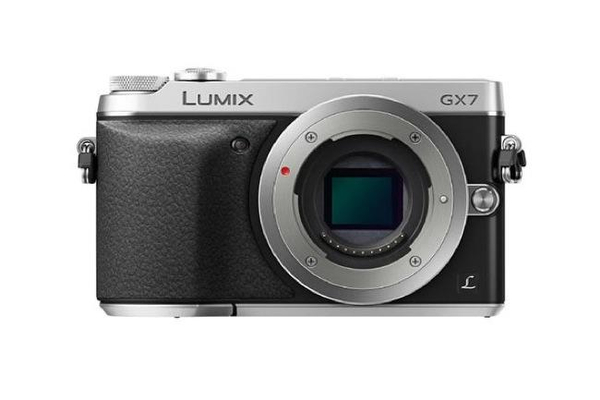
Preview: Panasonic Lumix GX7 underwater
I apologise for not being a regular contributor to either the Wetpixel equipment reviews or the forums but I can assure you that I’m a regular up to date lurker and I thought you might be interested in my experience of the Panasonic GX7 - a camera which I, personally, have eagerly awaited.
In terms of categorisation the GX7 is a 4/3rds interchangeable lens camera with a 16mp Live MOS sensor, a 3” tilting LCD and a built-in flip up 1024 x 768 pixel electronic viewfinder. It has front and rear control wheels like an SLR and a built-in flash so it provides everything needed in a comparatively compact body. It is similar in size to the Olympus PEN E-P5 and the Sony NEX-6. What sets the GX7 apart is the quality of both the still images and the video footage as well as the ability to customise it in many, very useful ways.
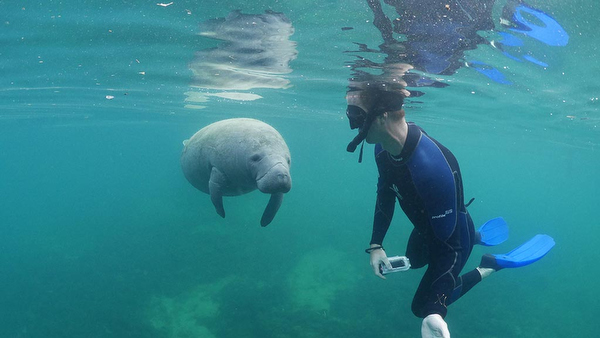
Earlier models on the GX and GH series of Panasonic cameras excelled at video but were decidedly ordinary for still images. In general terms the reverse is true with the Olympus Pen and EM-5 where the stills quality was excellent but the video footage lacked biting resolution. The Sony NEX cameras produce good stills and video but the manual white balance performance and menu system lets them down so the Panasonic GX7 ticked most of my boxes.
The GX7 has a newly developed sensor which it is claimed improves colour saturation and sensitivity by approximately 10% with a S/N ratio improvement of around 25%. All I can say is that the stills and video footage are very impressive indeed and on an equal footing to the GH3 but without the higher data rate and frame speed options. Since the GH3 is the standard by which a lot of SLRs are judged for video performance that puts the GX7 on a high pedestal and all this in a sub $1000 body. The final icing on the cake for me was being able to record .mov video files rather than AVHCD which I always had to convert before editing.
For me, as a mainly video shooter, the final attraction is the tilting LCD screen (rather than articulated as on the GH3 and GH3). This allows the camera to be held in a much more ergonomic way with your elbows tucked in rather than at arms length which is rather like shooting with a 2 legged tripod.
In addition, for land use there is a built in tiltable electronic viewfinder which is useful in bright sunlight but, to be quite honest, it’s fine for composition but not for judging focus. I usually let the autofocus perform better than I can but a nice touch with manual focus is an enlarged centre section to assess critical focus as well as a focus peaking indication which is really useful. Speaking of built-in things there’s also a integral pop-up flash which is ideal for triggering external strobes and the manual power can be reduced to 1/128th power for fast frame rates. It’s just nice to have everything built-in unlike the early Sony NEX and Olympus Pens with their add on viewfinders and flashes.
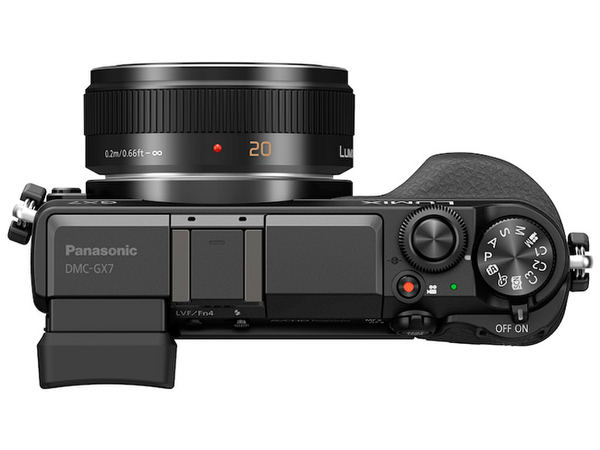
Time lapse and stop frame animation shooters are catered for as well as multi exposures so you see we have a camera that provides almost every function you need in a small, light footprint ideal for stress free travel and with a wide range of lenses from both Panasonic and Olympus as well as an increasing number of 3rd party lenses.
The other major attraction from such a small camera is its high ISO performance. You can get up to 25,600 if you want but the image quality is far from ideal. My rule of thumb is to come down 2 stops from the maximum ISO to get acceptable results so with the GX7 that, for me, means 6400. That’s for stills but, for some reason, Panasonic limit the maximum ISO to 3200 when shooting video. I can see no reason for this anomaly.
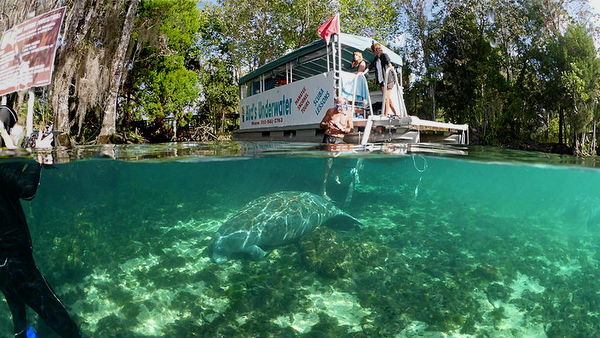
There is also a little heralded feature aimed mainly at video shooters called ‘Extra tele conversion’. This takes the centre 2 megapixel section of the chip which still gives full HD output but effectively increases the focal length by a factor of 2.4 with Full HD (this does vary with the aspect ratio you use). On land it is a very useful feature indeed - for example the reasonable sized 14-140mm F4-5.8 Panasonic lens is effectively a 28-280mm because of the sensor size but when you switch to Ext Tele Conv it becomes a 67-672mm without any loss of aperture! For video shooters underwater the 8mm fisheye would become a 38mm with very close focus capability and the excellent Olympus 12-50mm would become a close focus 57-240mm!
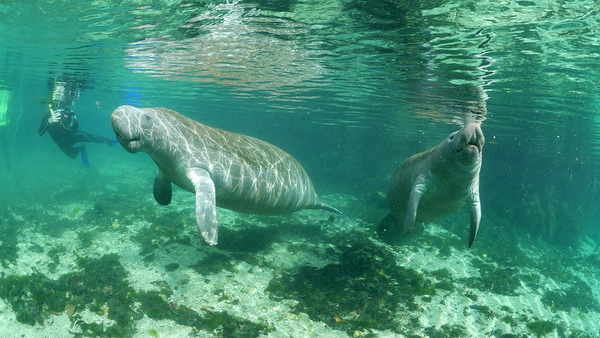
So all in all I think we have a very special camera here and I had the privilege of test driving it in the new Nauticam housing whilst snorkelling with manatees at Crystal River. I’m not going to go into too much detail about the housing because it was a pre production prototype and as such may be modified slightly for full production.
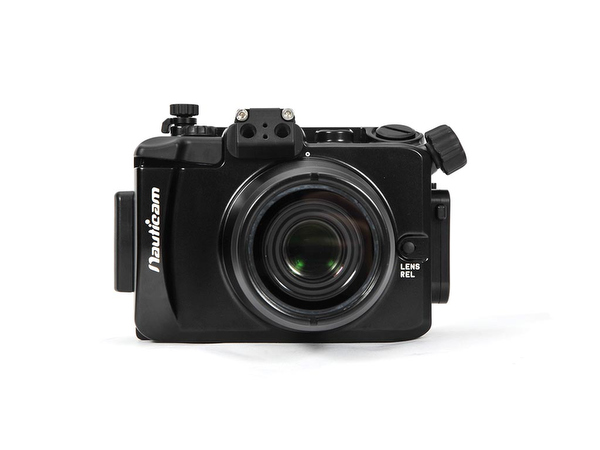
Suffice it to say I think it is a lovely housing which handles very well ergonomically with a right hand strap and a left hand handle. I used the 8mm fisheye which seems to go round corners it’s so wide! Size wise it is smaller than their GH3 housing yet there is still room for a leak detector/vacuum system (more on that later) and a most ingenious control to raise and lower the built in flash. The person who designed it should be applauded for their ingenuity.
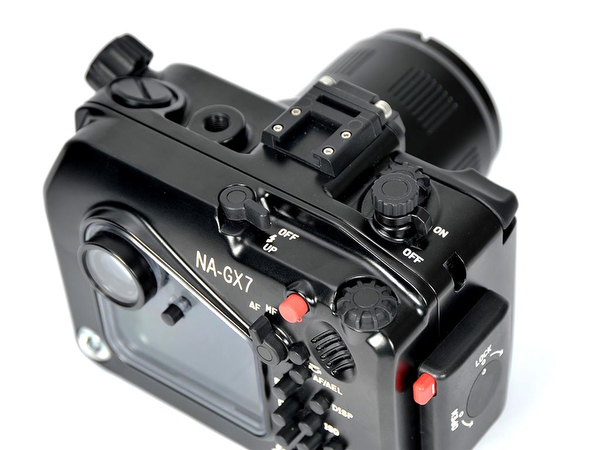
The other amazing fact is that this housing was produced in just 2 weeks from the date the camera was purchased. Add another 2 weeks for me to attend DEMA and use the housing for a couple of days and another few days to produce this review and you have what must surely be the fastest produced equipment review on record!
I am hoping to get one of the first production housings and will report in much more detail when they are finalised and I have been on a dive trip.
Nauticam Vacuum check and leak detection system
I also had a chance to use this system which, despite the compact size of the housing, fits in the Nauticam GX7 housing. It is very easy to set up and very reassuring throughout the dive.
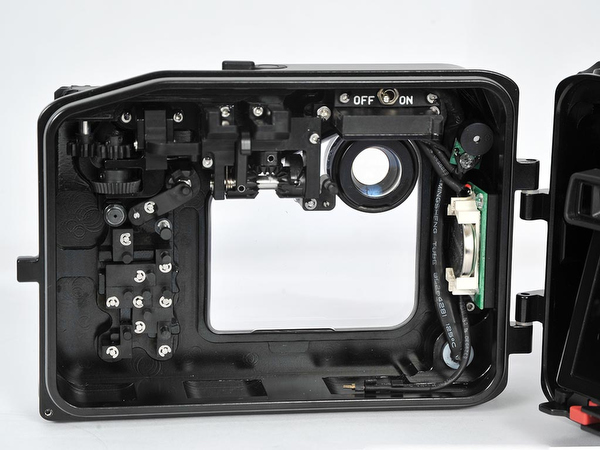
Having switched the unit on and closed the housing the cap is removed from the bulkhead connector and a small vacuum pump (similar to a wine bottle pump) is placed over it and pumped a few times. At ambient pressure, the LED slowly blinks blue. When a solid vacuum is achieved, the LED changes to a solid green, indicating system integrity. If the vacuum starts to degrade, the LED begins to flash yellow, and if water intrusion is detected, the LED flashes red, and the audible alarm is sounded. The whole setting up process takes literally seconds and then the bulkhead cap is reattached.
The appearance of that reassuring green light on the rear of the housing was a real breakthrough for me. I have dived for literally decades without a major flood so I’ve obviously been doing something right but having used this system for just a couple of days I would be loath to dive without one from now on.
FTTC disclosure. Nauticam were kind enough to lend Peter a housing for the review. The cameras was the reviewer’s own. Many thanks to Edward Lai of Nauticam.
About the author
Peter Rowlands has been taking pictures and shooting video since the 1970’s and is the owner and publisher of Underwater Photography magazine, a bi-monthly free online pdf magazine dedicated to all things underwater imaging. In addition, he is one half of Magic Filters and owns M.V Magic, a bespoke photo and video oriented dive boat based in Plymouth, UK.